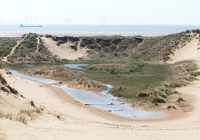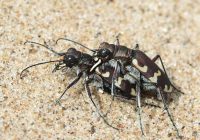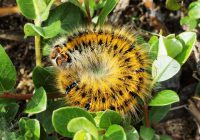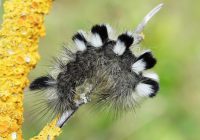Dr Phil Smith’s Wildlife Notes
May 2016
With small amounts of rain on only nine days during the month, May reinforced a statistically significant trend of lower spring rainfall here since 2000. A recent paper in the International Journal of Climatology confirms this trend for the UK as a whole, linking it to atmospheric pressure changes over Greenland brought about by warming in this part of the Arctic, which then impacts the north Atlantic Jet-stream.
The result for us was a rapid fall in the sand-dune water-table by about 1cm per day. Having had the prospect of the best Natterjack Toad breeding season for many years, we were almost back to square one, with surface water in the slacks rapidly drying up. This particularly affected the Devil’s Hole at Ravenmeols, where thousands of Natterjack tadpoles were isolated in rapidly desiccating shallow pools. A series of rescue operations towards the end of the month moved most of the tadpoles into deeper water. Will it survive long enough for them to metamorphose into baby toads? All we need is average rainfall but this seems to be a forlorn hope. In recent years, excavated scrapes have been the key to successful Natterjack breeding. I was delighted to find 77 adults at the Lifeboat Road scrapes on the evening of 3rd. But they were all large mature individuals, suggesting that, even here, recruitment of younger, smaller individuals has been poor for some years.
On a more optimistic note, May is one of the most visually attractive months, never failing to delight as trees suddenly erupt in foliage of different shades, from the yellowish-green tones of Black Poplars to the emerald of elms and the grey-greens of willows. Another characteristic landscape feature is the frothy white Cow Parsley, lining road verges as far as the eye can see, soon to be replaced by the superficially similar Hogweed.
Guided walks are one of the best ways of showing local residents the wildlife wonders on their doorsteps. The regular mid-May visits to the Altcar Training Camp to see the largest Green-winged Orchid colony in Northern England attracted groups of 22 and 26 participants. They saw a record number of nearly 32,000 of these glorious flowers. Careful timing of mowing has allowed the orchids to increase dramatically since the first few were found in 1985. A less spectacular ditch plant proved to be Blunt-fruited Water-starwort, for which the last Sefton Coast record was before 1930. Later, I led a walk organised by the Sefton Coast Landscape Partnership to the southern end of Birkdale Green Beach, the theme being coastal change. Here new duneland is rapidly forming, adding to coastal defences and creating fascinating pioneer habitats for plants and animals which struggle to survive in the more mature and overgrown areas of the dunes. As many as 33 people attended, enjoying a swarm of about 200 Southern Marsh-orchids where hardly any had been seen in 2015, showing how quickly changes occur.
Another exciting botanical find was a single large plant of Common Scurvy-grass by a footpath on the RSPB Marshside reserve. This species isn’t supposed to occur on the Ribble, being replaced by the similar English Scurvy-grass. Again, the former seems to be new to the Sefton Coast in modern times.
One of our “flag-ship” insects, the impressive Northern Dune Tiger Beetle relies on bare sand that heats up in the sun. One of the best places to see it has long been the giant blow-out known as the Devil’s Hole in the Ravenmeols dunes. Here, Trevor Davenport and I made a record count of 68 on 12th, including several mating pairs. Returning home, a Holly Blue butterfly was a welcome sight in my garden. Caterpillars on Alder and willows at Birkdale Green Beach included the very hairy and warningly coloured Yellowtail, Oak Eggar and Dark Tussock, the latter looking very like a toothbrush. I also found Grass Eggar caterpillars at the Devil’s Hole. With its distinctively ginger hairs, this is one of our many nationally notable moth species, being listed in the Red Data Book. At the month’s end, Trevor and I also visited Downholland Brook, just inland of Formby, where one of the most spectacular British insects, the Banded Demoiselle, put on a great display. We counted 13 males and five females. Moving on to Lunt Meadows Nature Reserve, more dragonflies included newly emerged Four-spotted Chasers as well as Azure and Blue-tailed Damselflies. We were also entertained by a female Shoveler with ten newly hatched ducklings.
There were relatively few unusual birds reported during the month, an exception being at Marshside where I caught up with a Glossy Ibis on 7th, followed two days later by a Garganey, three Little Gulls, a Black Tern and a Mediterranean Gull. During this period, Black Terns were widely reported in the region, being classically associated with easterly winds in May.




